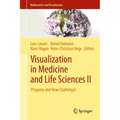In Situ Visualization for Computational Science: Mathematics and Visualization
Editat de Hank Childs, Janine C. Bennett, Christoph Garthen Limba Engleză Paperback – 6 mai 2023
This book provides an overview of the emerging field of in situ visualization, i.e. visualizing simulation data as it is generated. In situ visualization is a processing paradigm in response to recent trends in the development of high-performance computers. It has great promise in its ability to access increased temporal resolution and leverage extensive computational power. However, the paradigm also is widely viewed as limiting when it comes to exploration-oriented use cases. Furthermore, it will require visualization systems to become increasingly complex and constrained in usage. As research efforts on in situ visualization are growing, the state of the art and best practices are rapidly maturing.
Specifically, this book contains chapters that reflect state-of-the-art research results and best practices in the area of in situ visualization. Our target audience are researchers and practitioners from the areas of mathematics computational science, high-performance computing, and computer science that work on or with in situ techniques, or desire to do so in future.
| Toate formatele și edițiile | Preț | Express |
|---|---|---|
| Paperback (1) | 768.21 lei 43-57 zile | |
| Springer International Publishing – 6 mai 2023 | 768.21 lei 43-57 zile | |
| Hardback (1) | 1173.28 lei 43-57 zile | |
| Springer International Publishing – 5 mai 2022 | 1173.28 lei 43-57 zile |
Din seria Mathematics and Visualization
- 20%
 Preț: 935.20 lei
Preț: 935.20 lei - 18%
 Preț: 960.93 lei
Preț: 960.93 lei - 18%
 Preț: 1110.41 lei
Preț: 1110.41 lei - 20%
 Preț: 994.26 lei
Preț: 994.26 lei - 18%
 Preț: 1220.57 lei
Preț: 1220.57 lei - 18%
 Preț: 958.38 lei
Preț: 958.38 lei - 15%
 Preț: 654.62 lei
Preț: 654.62 lei - 20%
 Preț: 997.38 lei
Preț: 997.38 lei - 15%
 Preț: 645.47 lei
Preț: 645.47 lei - 5%
 Preț: 1101.58 lei
Preț: 1101.58 lei - 20%
 Preț: 992.44 lei
Preț: 992.44 lei - 20%
 Preț: 1284.47 lei
Preț: 1284.47 lei - 20%
 Preț: 656.69 lei
Preț: 656.69 lei - 20%
 Preț: 476.68 lei
Preț: 476.68 lei - 20%
 Preț: 1273.08 lei
Preț: 1273.08 lei - 15%
 Preț: 649.54 lei
Preț: 649.54 lei - 20%
 Preț: 335.36 lei
Preț: 335.36 lei - 20%
 Preț: 646.95 lei
Preț: 646.95 lei - 20%
 Preț: 651.75 lei
Preț: 651.75 lei - 20%
 Preț: 657.99 lei
Preț: 657.99 lei - 18%
 Preț: 1223.74 lei
Preț: 1223.74 lei - 20%
 Preț: 333.72 lei
Preț: 333.72 lei - 20%
 Preț: 709.98 lei
Preț: 709.98 lei - 18%
 Preț: 1236.38 lei
Preț: 1236.38 lei - 20%
 Preț: 992.26 lei
Preț: 992.26 lei - 20%
 Preț: 648.44 lei
Preț: 648.44 lei - 20%
 Preț: 1158.59 lei
Preț: 1158.59 lei - 20%
 Preț: 330.66 lei
Preț: 330.66 lei - 18%
 Preț: 963.91 lei
Preț: 963.91 lei - 15%
 Preț: 653.98 lei
Preț: 653.98 lei - 20%
 Preț: 991.94 lei
Preț: 991.94 lei - 18%
 Preț: 958.07 lei
Preț: 958.07 lei
Preț: 768.21 lei
Preț vechi: 960.27 lei
-20% Nou
Puncte Express: 1152
Preț estimativ în valută:
146.99€ • 153.89$ • 121.63£
146.99€ • 153.89$ • 121.63£
Carte tipărită la comandă
Livrare economică 07-21 aprilie
Preluare comenzi: 021 569.72.76
Specificații
ISBN-13: 9783030816292
ISBN-10: 303081629X
Ilustrații: XV, 460 p. 201 illus., 184 illus. in color.
Dimensiuni: 155 x 235 mm
Greutate: 0.66 kg
Ediția:1st ed. 2022
Editura: Springer International Publishing
Colecția Springer
Seria Mathematics and Visualization
Locul publicării:Cham, Switzerland
ISBN-10: 303081629X
Ilustrații: XV, 460 p. 201 illus., 184 illus. in color.
Dimensiuni: 155 x 235 mm
Greutate: 0.66 kg
Ediția:1st ed. 2022
Editura: Springer International Publishing
Colecția Springer
Seria Mathematics and Visualization
Locul publicării:Cham, Switzerland
Cuprins
In Situ Visualization for Computational Science: Background and Foundational Topics.- Data Reduction Techniques.- Sampling for Scientific Data Analysis and Reduction.- In Situ Wavelet Compression on Supercomputers for Post Hoc Exploration.- In Situ Statistical Distribution-based Data Summarization and Visual Analysis.- Exploratory Time-Dependent Flow Visualization via In Situ Extracted Lagrangian Representations.- Workflows and Scheduling.- Unlocking Large Scale Uncertainty Quantification with In Transit Iterative Statistics.- Decaf: Decoupled Dataflows for In Situ Workflows.- Parameter Adaptation In Situ: Design Impacts and Trade-offs.- Resource-aware Optimal Scheduling of In Situ Analysis.- Tools.- Leveraging Production Visualization Tools In Situ.- The Adaptable IO System (ADIOS).- Ascent: A Flyweight In Situ Library for Exascale Simulations.- The SENSEI Generic In Situ Interface: Tool and Processing Portability at Scale.- In Situ Solutions with CinemaScience.- New Research Results and Looking Forward.- Deep Learning-based Upscaling for In Situ Volume Visualization.- Scalable CPU Ray Tracing for In Situ Visualization Using OSPRay.- Multivariate Functional Approximation of Scientific Data.- A Simulation-Oblivious Data Transport Model for Flexible In Transit Visualization.- Distributed Multi-tenant In Situ Analysis using Galaxy.- Proximity Portability and In Transit, M-to-N Data Partitioning and Movement in SENSEI.
Textul de pe ultima copertă
This book provides an overview of the emerging field of in situ visualization, i.e. visualizing simulation data as it is generated. In situ visualization is a processing paradigm in response to recent trends in the development of high-performance computers. It has great promise in its ability to access increased temporal resolution and leverage extensive computational power. However, the paradigm also is widely viewed as limiting when it comes to exploration-oriented use cases. Furthermore, it will require visualization systems to become increasingly complex and constrained in usage. As research efforts on in situ visualization are growing, the state of the art and best practices are rapidly maturing.
Specifically, this book contains chapters that reflect state-of-the-art research results and best practices in the area of in situ visualization. Our target audience are researchers and practitioners from the areas of mathematics computational science, high-performance computing, and computer science that work on or with in situ techniques, or desire to do so in future.
